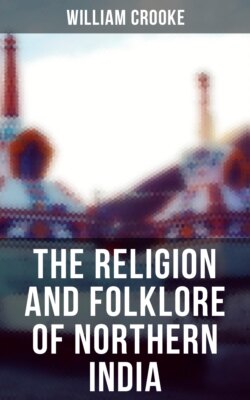Читать книгу The Religion and Folklore of Northern India - William Crooke - Страница 13
На сайте Литреса книга снята с продажи.
Sun-worship in the Domestic Ritual.
ОглавлениеTable of Contents
It is needless to say that the custom of walking round any sacred object in the course of the sun prevails widely. Thus in Ireland, when in a graveyard, it is customary to walk as much as possible “with the sun,” with the right hand towards the centre of the circle.20 Even to this day in the Hebrides animals are led round a sick person, following the sun; and in the Highlands it is the custom to make the “deazil” or walk three times in the sun’s course round those whom they wish well. When a Highlander goes to bathe or to drink water out of a consecrated spring, he must always approach by going round the place from east to west on the south side, in imitation of the daily motion of the sun.21 We follow the same rule when we pass the decanters round our dinner tables. In the same way in India the bride and bridegroom are made to revolve round the sacred fire or the central pole of the marriage-shed in the course of the sun; the pilgrim makes his solemn perambulation (parikrama) round a temple or shrine in the same way; in this direction the cattle move as they tread out the grain.
One special part of the purificatory rite following childbirth is to bring the mother out and expose her to the rays of the sun. All through the range of popular belief and folk-lore appears the idea that girls may be impregnated by the sun.22 Hence they are not allowed to expose themselves to his rays at the menstrual period. For the same reason the bride is brought out to salute the rising sun on the morning after she begins to live with her husband. A survival of the same belief may be traced in the English belief that happy is the bride on whom the sun shines. The same belief in the power of the sun is shown in the principle so common in folk-lore that to show a certain thing to it (in a Kashmîr tale it is a tuft of the hair of the kindly tigress) will be sufficient to summon an absent friend.23
The mystical emblem of the Swâstika, which appears to represent the sun in his journey through the heavens, is of constant occurrence. The trader paints it on the fly-leaf of his ledger; the man who has young children or animals liable to the Evil Eye makes a representation of it on the wall beside his door-post; it holds the first place among the lucky marks of the Jainas; it is drawn on the shaven heads of children on the marriage-day in Gujarât; a red circle with a Swâstika in the centre is depicted on the place where the gods are kept.24 In those parts of the country where Bhûmiya is worshipped as a village guardian deity his votary constructs a rude model of it on the shrine by fixing up two crossed straws with a daub of plaster. It often occurs in folk-lore. In the drama of the “Toy Cart” the thief hesitates whether he shall make the hole in the wall of Charudatta’s house in the likeness of a Swâstika or of a water jar. A hymn of the Rigveda25 speaks of the all-seeing eye of the sun whose beams reveal his presence, gleaming like brilliant flames to nation after nation. This same conception of the sun as an eye is common in the folk-lore of the West.26
